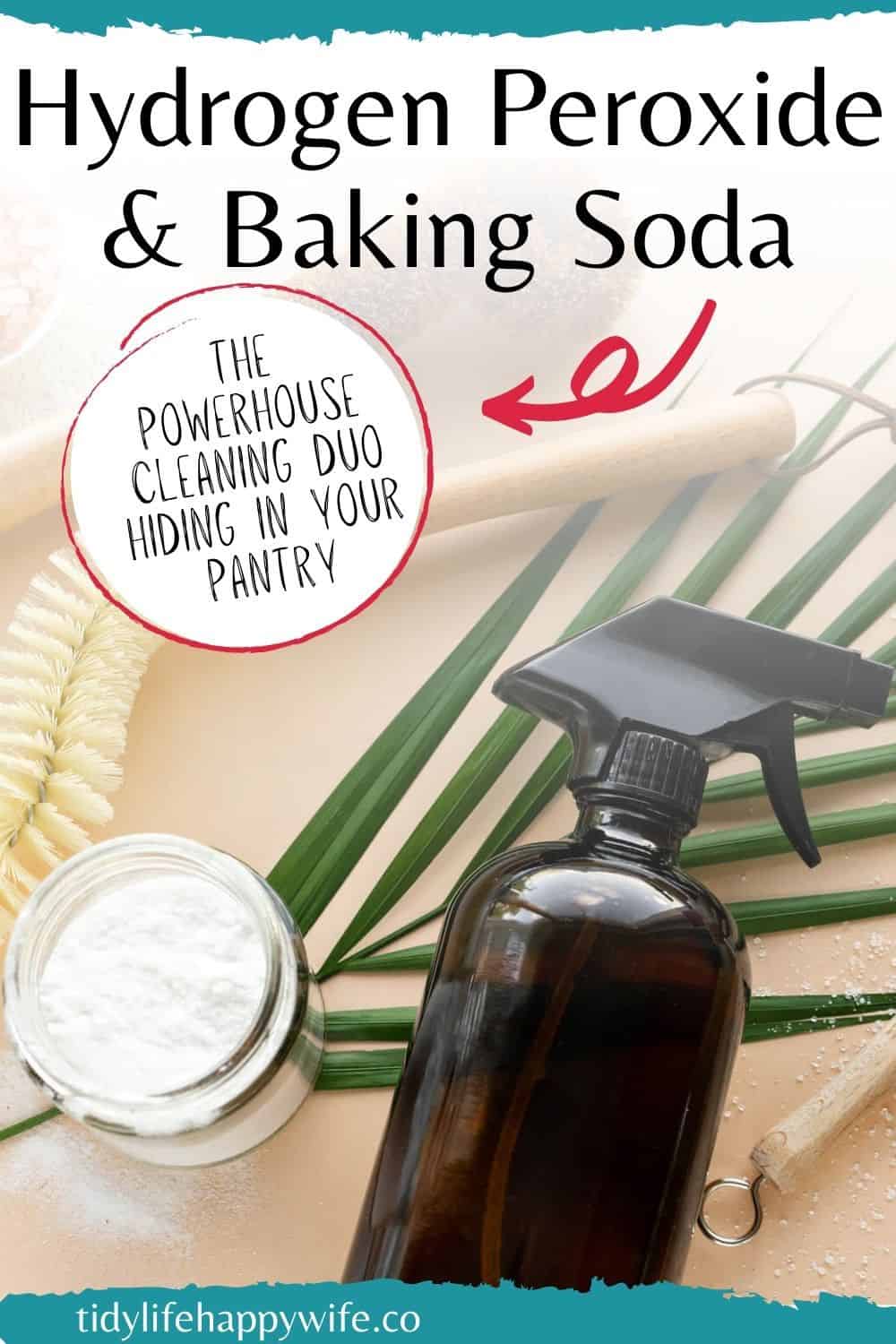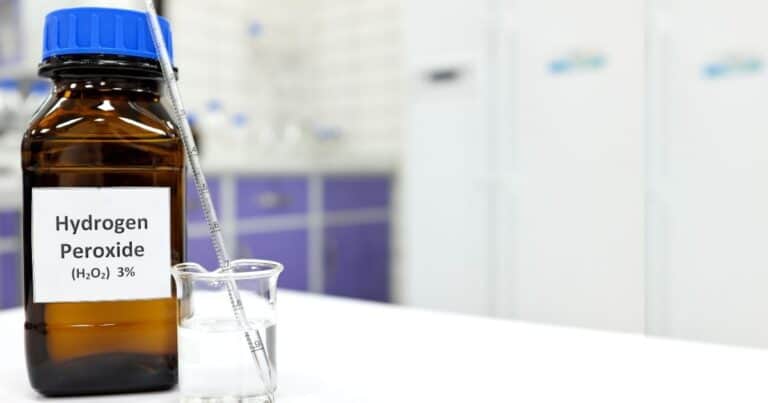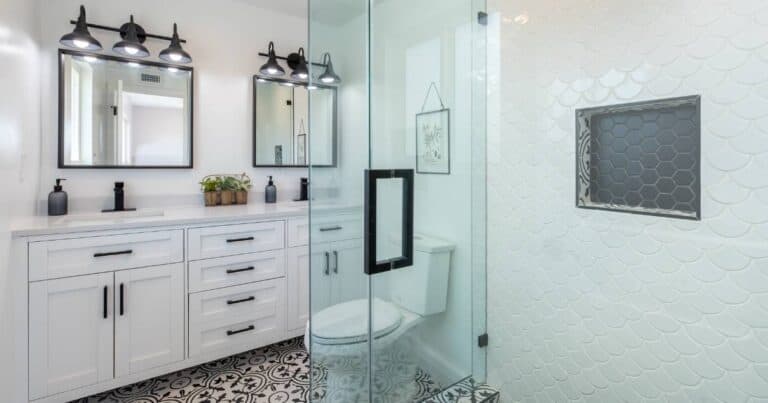11 Tough Messes You Should Clean with Hydrogen Peroxide and Baking Soda
Stop wasting money on fancy, name-brand cleaners that don’t work? Make cleaning easier by using the hydrogen peroxide and baking soda powerhouse duo that’s hiding out in your pantry and medicine cabinet.
I grew up using bleach and white vinegar for cleaning everything. When I got my first apartment, I tried every commercial product on the market.
Most of them did a mediocre job if I could get past the strong smell. Some were so bad they took my breath away just like the bleach and vinegar.
The first time I tried hydrogen peroxide and baking soda to clean my toilet was the day I threw out more than a dozen, barely used bottles of expensive cleaner. My toilet looked brand new and I’d barely started scrubbing. Plus there was absolutely zero odor.
Since then, it’s been one of my favorite cleaning tips to share with friends.
Is mixing hydrogen peroxide and baking soda safe?
Hydrogen peroxide and baking soda are completely safe and are even recommended for cleaning and whitening your teeth.
The combination can also conquer some of your toughest cleaning jobs including baked-on grease, dingy grout, laundry stains, and hard water buildup.
Hydrogen peroxide is a strong oxidizer (bleach) and mild acid1. It’s very effective at breaking down protein and plant-based stains including bacteria, fungi, and spores. This makes hydrogen peroxide a pretty effective cleaner all on its own.
It can be slightly irritating to sensitive skin, so be sure to wear rubber gloves when using it for cleaning.
Baking soda (sodium bicarbonate) is a strong alkaline and mild abrasive2. It’s great for scrubbing, neutralizing odors, and dissolving grease into a water-soluble compound.
What happens when you mix hydrogen peroxide and baking soda?
When you mix hydrogen peroxide and baking soda, it causes an exothermic chemical reaction that turns it into the grease and mineral-busting cleaning powerhouse that I love.
The Hydrogen Peroxide and Baking Soda Reaction
The exothermic reaction generates and releases a minor amount of carbon dioxide gasses. As the gasses are released, the mixture neutralizes and becomes completely water-soluble.
Caution: Only mix as much as you can use at one time and NEVER store the mixture in a closed container. The carbon dioxide gasses will eventually build enough pressure inside the container to cause it to burst open and spray everywhere.
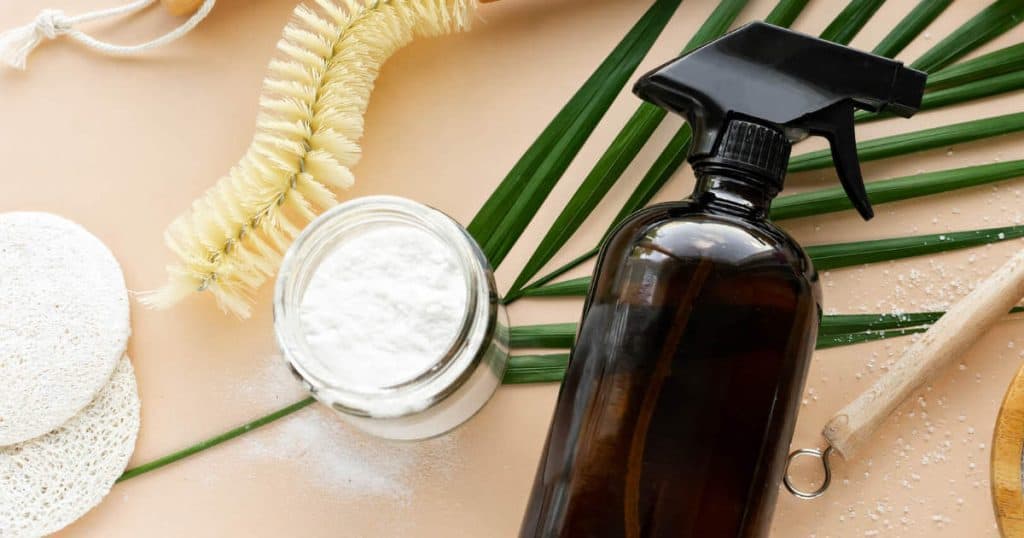
This post may contain affiliate links. Please see my disclosure policy for details.
Cleaning with Hydrogen Peroxide and Baking Soda
Due to its antibacterial, bleaching, and grease-busting cleaning powers, the duo can be used to effectively clean most household messes. It’s particularly effective on tough, protein-based messes, and is a great addition to your regular cleaning routine.
1. Degrease Sheet Pans/Cookie Sheets
Are your sheet pans and cookie sheets brown and sticky even after you wash them in hot water? That’s grease starting to bake onto the surface.
The most effective way to clean sheet pans is by covering them with a thick paste of baking soda and hydrogen peroxide. Let the mixture sit for 10 to 15 minutes.
If it has started to dry out, spritz with a little peroxide to moisten. Scrub with a clean sponge. Rinse under hot running water, and dry.
If your pans are completely covered, run them under hot water for a few minutes before applying the mixture. This will heat the cooked-on mess and help the mixture to penetrate and dissolve the grease.
2. Brighten Dingy Grout with Hydrogen Peroxide and Baking Soda
Clean and lighten your dirty grout by applying a thin mixture of peroxide and baking soda along the grout lines.
If you’re working with vertical surfaces, add a half teaspoon of baking soda a little at a time to thicken the mixture so it stays put.
Let the mixture work its magic for 15 to 20 minutes. Scrub the grout with a stiff bristle grout brush.
Wipe clean with a damp sponge to remove all traces of baking soda. Let dry. Super grungy grout may need a couple of cleaning sessions.
Pro Tip: Once the grout is dry, apply a good sealer to protect it. Hydrogen peroxide is a bleaching agent and will remove any sealer you previously applied. Clean and reseal once a year to make cleaning super easy.
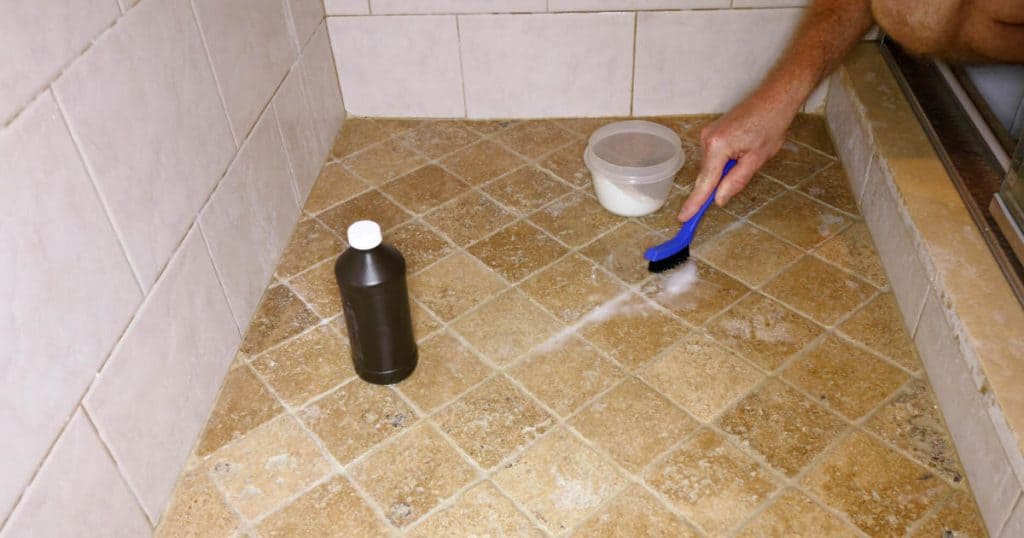
3. Remove Cooked on Grease From Non-Ceramic Pots and Pans
Are the cooked-on grease drips and spots on the exterior of your pans driving you crazy? Make them disappear with peroxide and baking soda.
Rinse the outsides of the pans with hot water to soften the cooked-on mess. Cover with a paste of baking soda and peroxide. Let it sit for 15 to 10 minutes.
Scrub with a scrubby sponge and rinse under warm water.
4. Knock Out Soap Scum
Soap scum is a pain and if you’re using bar soap, it’s building up quicker than you can remove it.
Blast soap scum by scrubbing with a stiff scrub brush and a paste of hydrogen peroxide and baking soda.
I pre-treat by spraying walls with hydrogen peroxide. Let it sit for 10 minutes, then use a clumpier paste and scrubby sponge to clean the shower walls and floor.
Rinse and let air dry.
If your shower glass still looks hazy, here are some more ideas for removing those hard water stains from your shower doors.
5. Descale Your Faucets with Baking Soda and Hydrogen Peroxide
You’ve probably heard of using vinegar to descale the buildup around your faucets. I stay away from vinegar because it damages so many surfaces.
Instead, try the baking soda and hydrogen peroxide cleaner.
Spritz the scale with a little hydrogen peroxide. Mix a paste of hydrogen peroxide and baking soda. Apply the mixture to the buildup until it’s completely covered.
Cover the area with plastic wrap and let it sit for 15 to 20 minutes. Remove the plastic wrap and scrub the scale with a stiff-bristled grout brush until it’s gone.
Once dry, rub the area with wax paper or auto wax to slow the scale buildup.
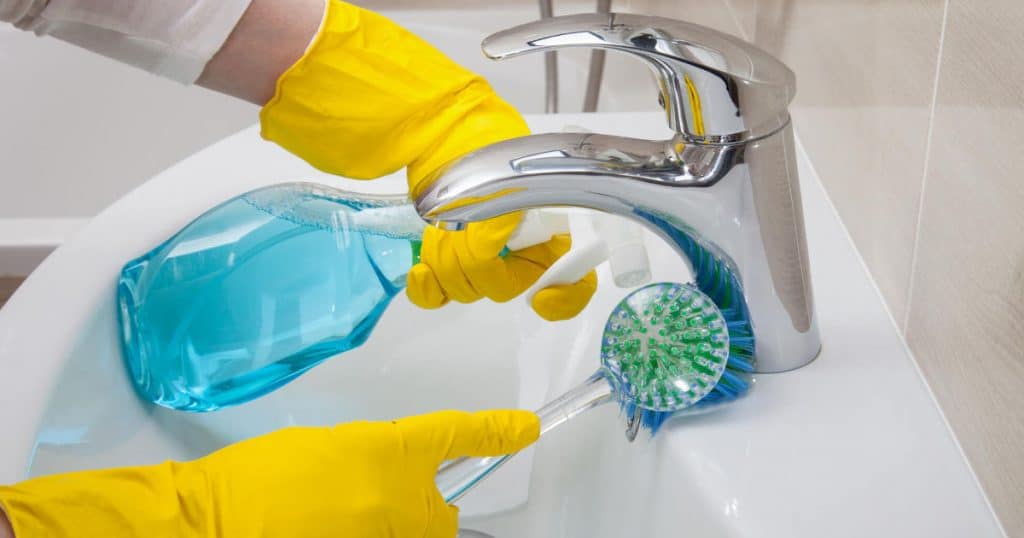
6. Blast Through Burnt on Food
Think you ruined your favorite pot by scorching the clam chowder? Don’t throw it out just yet.
Use a nylon scraper to remove as much of the mess as possible. Spray the bottom of the pan with enough hydrogen peroxide to completely cover the burnt-on mess.
Sprinkle baking soda to cover the same area. Let it sit for 25-30 minutes.
If the baking soda appears to be drying out, spritz with more peroxide. When time is up, scrape with the nylon scraper again, then scrub with a scrubby sponge to remove the mess.
7. Clean Hard Water Build-Up off of Non-Metal Utensils
Have you noticed any cloudy white smudges or smears on your nylon, plastic, or silicone kitchen tools? These are mineral deposits from hard water. They’re harmless but unsightly.
To remove, create a paste of hydrogen peroxide and baking soda. Dip a damp microfiber cloth in the mixture and scrub the cloudy spots until they’re gone. Rinse and dry.
Hand wash and dry your utensils to prevent the buildup from returning.
GET YOUR CLEANING DONE DURING THE WEEK!
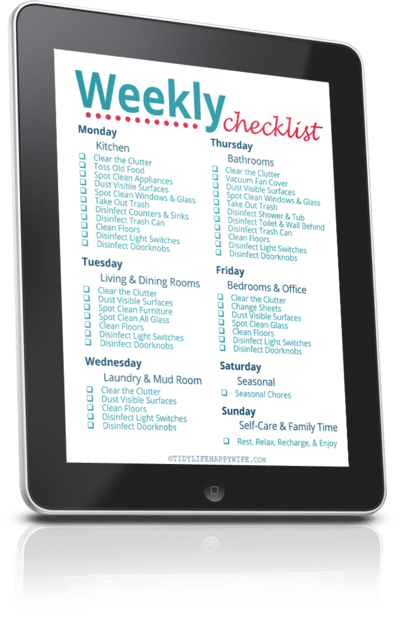
Join thousands of VIPs for cleaning, decluttering, and organizing tips sent straight to your inbox. As a welcome gift, we’ll send you this FREE printable Weekly Cleaning Checklist that lists exactly what to deep clean in every room of your home.
8. Use Peroxide and Baking Soda as a Stain Remover
Are you still battling blood, sweat stains, deodorant buildup, grease, or grass stains on your laundry? Hydrogen peroxide and baking soda are the best natural cleaning ingredients for those nasty messes.
For best results, mix a paste of baking soda and 3% hydrogen peroxide solution in a bowl. Place a small amount of the paste on the stained area.
Use an old toothbrush or nail brush to scrub the area for a few minutes. If the paste is too thick to scrub, just add a couple of drops of water to thin it out a little.
Rinse with clean water and launder as usual.
You’ll have your favorite blouse and stained white shoes looking brand new in no time.
Pro Tip: Always test colored fabrics in an inconspicuous area as hydrogen peroxide is a bleaching agent and will lighten or remove the color from some fabrics.
9. Disinfect Water Bottles
Do your water bottles need a good deep cleaning? Hydrogen peroxide and baking soda have you covered.
Fill the bottle 1/4 full with hydrogen peroxide, then sprinkle in a few teaspoons of baking soda.
Put the lid on briefly to agitate the mixture. Gently roll the bottle back and forth to coat the entire interior with the solution.
Open the spout on the lit to slowly release the gasses, then remove the lid. Do not leave the lid on the bottle because the gasses will build up and cause excess pressure.
Let the bottle and lid sit for 10 to 15 minutes. Rinse and let air dry.
The peroxide will kill any bacteria, and the baking soda helps ‘scrub’ the interior surfaces.
10. Clean Your Toilet with Baking Soda and Hydrogen Peroxide
Toilet bowl rings can be some of the toughest to clean but hydrogen peroxide and baking soda make it super easy.
Turn off the water and drain your toilet by dumping a large pan or bucket of water in the bowl. Use some paper towels to dry the areas that need to be cleaned.
Mix a thick paste of baking soda and hydrogen peroxide in a small bowl. Paint it over the dirty areas and let it sit for a couple of minutes.
Add a little baking soda to your remaining paste to make it clumpy. Use the thicker paste to start scrubbing the dirty areas with a toilet brush.
When you’re all done, flush the toilet a couple of times to give it a good rinse. Your toilet will be sparkling clean.
11. Remove Hard Water Spots from Cooking Utensils
Do you ever get that white powdery buildup on your plastic, nylon, and silicone cookware and utensils when you run it through the dishwasher? Those are mineral spots from hard water.
Get rid of them quickly by mixing up a thick paste of baking soda and peroxide. Cover the powdery spots, scrub, then rinse and dry.
Your cookware and utensils will look brand new.
Mixing Baking Soda and Hydrogen Peroxide
Depending on the application, you’ll want to control how thick or thin your mixture is.
Clumpy mixes (think blue cheese crumbles) work best when you need extra scouring power. I use a clumpier mix for tackling soap scum and cleaning hard water stains off of non-metal utensils.
A thick but runny mix (think molasses or old paint) works best when you need it to spread and stick to vertical surfaces. You should be able to put the thicker mixture on vertical surfaces and some of it will run down, but some will also stick and stay in place.
I use runny mixes for descaling my faucets and removing the cooked-on grease from the outside of my pans.
The thin, runny mix (think syrup) works best for flat surfaces that can contain the spread. If you run your finger through the middle of the mixture, it should quickly fill back in and cover that bare spot.
I use the thin mixture for baking sheets and the initial soak on burnt-on food, then I add baking soda to thicken it up for extra scrubbing power.
There are many factors that can change how your mixture reacts including how clumpy your baking soda is, and how old your peroxide is.
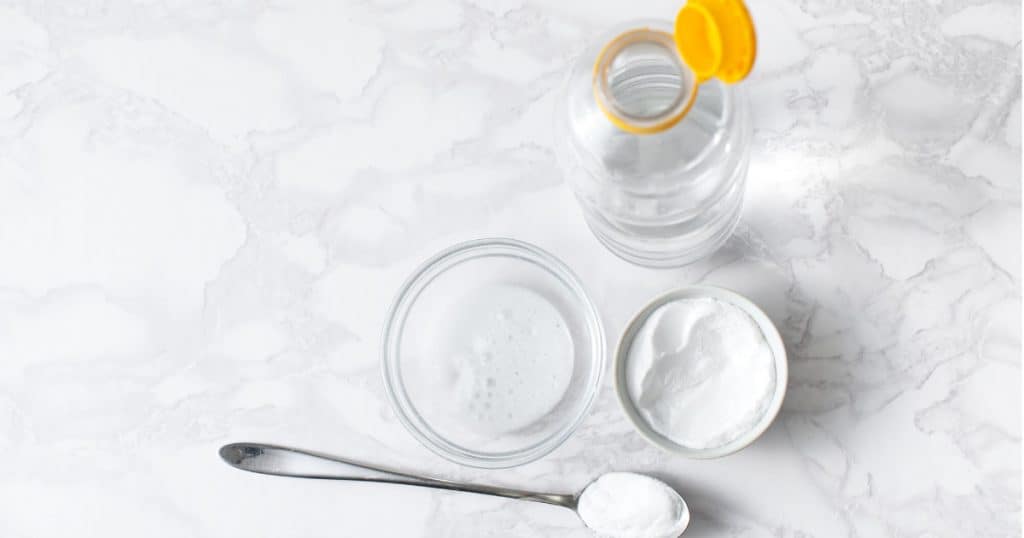
Mix Ratios for Cleaning
Here are some mix ratios to get you started, and how to fix them if they aren’t quite right.
- Clumpy – 3 parts baking soda to 1 part hydrogen peroxide
- Thick – 2.5 parts baking soda to 1 part hydrogen peroxide
- Thin – 1 part baking soda to 1 part hydrogen peroxide
If the mixture is too runny for your application, slowly add baking soda and mix thoroughly. If it’s too thick or clumpy add peroxide. I use my spray bottle when adding peroxide so I don’t ‘overpour’.
Keep Your Home Sparkling Clean with Hydrogen Peroxide and Baking Soda
Stop wasting your money on name-brand cleaners. Harness the cleaning power of 2 ingredients hiding right in your pantry and medicine cabinet.
Hydrogen peroxide and baking soda combine to create a safe yet incredibly powerful cleaning mixture capable of conquering your toughest household messes.
Baked on grease, laundry stains, burnt-on food, and hard water build-up are no match for this duo. You can even use it to clean and disinfect your water bottles, clean and brighten your grout, and melt away soap scum.
They’re perfectly safe to mix, and your mixture can be easily adjusted to fit your specific cleaning needs.
Not sure what you should be cleaning? Check out my Spring Cleaning Checklist for some ideas.
1 Hydrogen Peroxide – Natural Library of Medicine
2 Sodium Bicarbonate – Wikipedia

